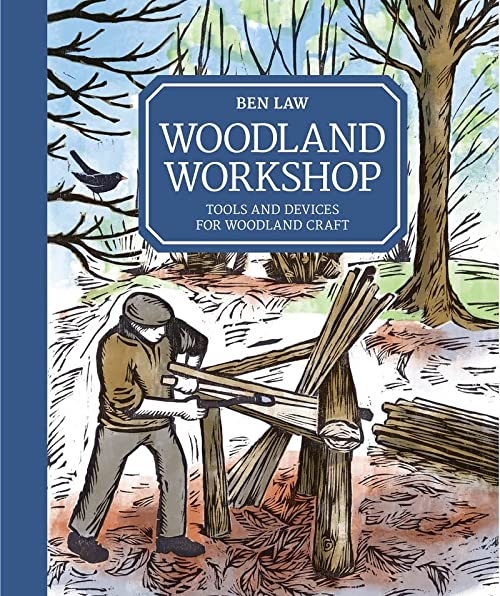From Living Woods Issue 50
Woodland worker and no mean craftsman himself, RICHARD HARE casts an admiring eye over Ben Law’s new book on green woodworking.
 WOODLAND WORKSHOP
WOODLAND WORKSHOP
Tools and Devices for
Woodland Craft
Ben Law
GMC Publications
208 pages
ISBN 978-1784943431
Ben Law’s latest offering is a nicely presented and personal account of the tools and workshop set-up he employs at his workplace in Prickly Nut Wood. The book’s cover has an appropriately rural scene of the author splitting pales in the wood. Inside, it is peppered with a mixture of hand-drawn illustrations and photographs which help the reader follow the prose, making his instructions clear and easy to follow. He describes some of the devices in the book as another ‘pair of hands’; this together with the chapter on sharpening reminds us that the fundamentals of green woodworking, or any woodworking for that matter, are to have a sharp tool and a good firm method of gripping the work.
Ben is not afraid of modern innovations and the ease and efficiency they can bring to a job. The section on ‘Key Tools’ gives us an overview of some of the traditional hand tools which have been around for many hundreds of years whilst acknowledging that modern power tools like the cordless drill have a place, especially for the commercial or semi-commercial craftsman. Particularly inspiring are the detailed instructions for the different types of shave horse he uses. If you’ve creaked and groaned when dismounting your shave horse after an hour or two in the saddle, you could do worse than try constructing the ‘easy rider’, a style developed by his friend and colleague Sean Hellman.
The book is a real delight, you might read it straight through, or dip into it as and when needed. Some of the projects are as simple as looking for the right shaped tree to make a chopping block; others like the pole lathe or framing beds for roundwood timber framing will require more resources and skill to complete and may not be relevant to you. However, there are some gems in here and whatever level you are at, you are bound to find something which gives you an ‘aha . . . that makes sense’ moment. I particularly like the way he relates the modern refinements he has made with the traditional versions which have been around for many years and the potted history he gives us at the end of each section.
Even if you are already an experienced green woodworker, this volume may help you take another look at how you’ve been working and how you might improve your efficiency and comfort with some of Ben’s ideas. If you are just starting out it will be a valuable addition to your workshop bookshelf.
I just wonder how much extra we would have to pay to have it printed and bound locally rather than in China? It seems a little paradoxical that a book otherwise reeking in sustainability is printed on paper which has travelled half way around the world, but maybe that’s a discussion for another time.